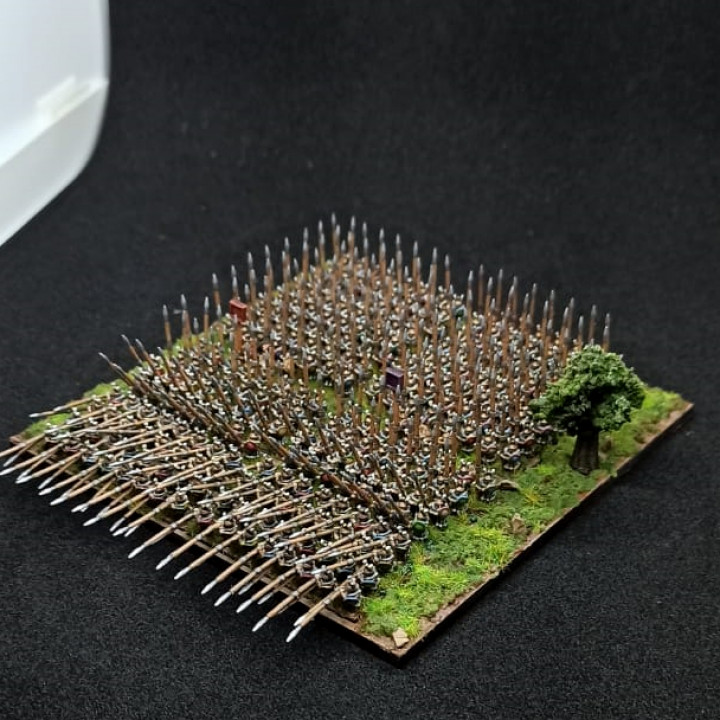
$5.00Microscale 6mm Macedonian Phalanx
myminifactory
SUMMARY These are Macedonian/Successors Alexandrian pikemen for 6mm. There are 8 strips so you can make many types of formations, including attacking with interlocking pikes (a first at this scale, I believe.) The strips are numbered in such a way that if you print one of each and place number 1 first and 8 last, you'll get the classic look of a phalanx attacking, with pikes at different angles. See the picture with painted minis: the first eight rows (128 men) is more or less how it should look like. Strips 1-2: pikes parallel to the ground and (for 2) pointing somewhat downwards. Strips 3-4: pikes pointing slightly upwards. Strips 5-6: pikes at a wider angle. Strips 7-8: pikes at rest, the classic miniature look. The models come in strips of eight units, in supported (sup-x.stl) and unsupported versions (x-no-sup.stl,) except for the seventh and eight as those can be printed directly on the plate and need no supports. There's also an optional command strip. Strips 1-5 also have their number (in Roman numerals) engraved on the underside of the strip base so you don't mix them together, as strips I to IV are fairly similar. Don't worry about the pikes getting all jumbled up or stabbing the guys in front. Strips I, II, and III fit perfectly, and no friendly poking should happen. Strips III's & IV's pikes might touch or rest on the tip of the helmet of the unit in front of them, but that's it. DESCRIPTION These ancient soldiers are armed with the famous sarissa. Although it's easy to assume these were heavy troops, they were actually fairly lightly armored compared to the Greek hoplites, as shown by their linothorax armor and their smaller shield. Their oddly-shaped head is due to their Phrygian helmet, with a feather at each side (which I painted as such, but you can paint the entire thing as metal, of course.) It is not clear how the officers of an Alexandrian phalanx fought, and most manufacturers at this scale don't even include officers. I have followed Graham Wrightson (2010)* theory, which states that Macedonian officers didn't fight at the front lines but stood behind to coordinate (in fact, he argues they were in the middle, with a reserve of troops behind them, as shown in one of my pictures.) *"The Nature of Command in the Macedonian Sarissa Phalanx" Printing Tips I recommend removing the supports before curing. Use pliers or similar cutting tool to remove the supports under the base first. That tension might remove some of the other supports (and some might already be detached from the miniature—that is normal.) For the supports attached to the pikes, use a hobby knife or a similar sharp tool and slice under the pike. Finally, remove (if there are any) the small supports at the butt of the pike or under the shield. Strips III & IV have an in-built ramp/support connecting the shield to the "skirt". It is hardly noticeable, but if it bothers you, you can try removing it with a very sharp hobby knife. For manipulating the strips, especially before curing, I highly recommend using tweezers. Once cured, glue them to some piece of cardboard and paint them. I have printed these at 0.02, 0.03, and 0.04, and they look fine. Your default printing settings should be fine
With this file you will be able to print $5.00Microscale 6mm Macedonian Phalanx with your 3D printer. Click on the button and save the file on your computer to work, edit or customize your design. You can also find more 3D designs for printers on $5.00Microscale 6mm Macedonian Phalanx.
